The Garden Helper's Plant of the WeekEach week we will showcase a new plant that has a profile on The Garden HelperIf you like these quick peaks of the plants, please check out their full profile. You'll find many more profiled plants listed in the "More Plants and Flowers" column. Click on any photograph to enlarge. |
More Plants and FlowersOctober 2011November 2011 January 2011 February 2011 March 2011 April 2011 May 2011 June 2011 July 2011 August 2011 Plants of 2012 |
September 1, 2011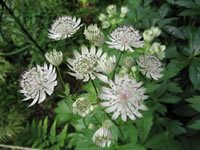 Masterwort Astrantia maxima Masterworts have bright green, palmate leaves with 5-7 fingers. From early to mid-summer, they produce wirey, top-branched stems with intricately formed, ¾"-1¼" umbels of tightly packed, 5 petaled flowers, surrounded by a ring of papery, petal-like bracts. An excellent addition to the moist areas in your shaded or woodland gardens. Hardy in USDA zones 5-9 |
September 4, 2011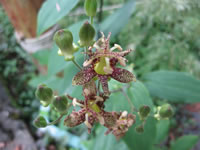 Toad Lily Tricyrtis hirta The Common Toad Lily is an easy to care for, slow spreading, clump forming perennial with 4"-6", deep green leaves alternating along multiple, 30"-36" upright, arching stems, resembling those of an orchid. Tricyrtis hirta produces loose clusters of individual, white or yellow, orchid like flowers covered with hundreds of tiny, dark purple or burgundy colored spots. Hardy in USDA zones 4-9 |
September 11, 2011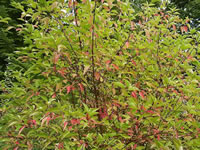 Red Twig Dogwood Cornus stolonifera Dogwoods are an extremely important source of food for song birds as they migrate their way to the south this fall. Red Twig Dogwoods (aka: Red-Osier Dogwoods) form multi-stemmed shrubs that produce clusters of tiny white flowers in the Spring. Berries appear later and remain until winter to provide a treat for the birds. The foliage turns to a deep crimson red in the fall. After the leaves drop in early winter, the stems turn to a bright red, creating a dramatic silouette in your garden Hardy in USDA zones 3-10 |
September 18, 2011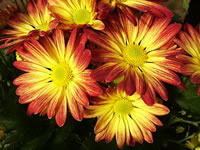 Chrysanthemum Plant some Mums now, for fall color in your garden! Chrysanthemums grow best and produce the most flowers if they are planted in full sunshine. They respond to plenty of food and moisture. There are hundreds of varieties of Chrysanthemums, giving you a multitude of options for height, color, flower size and time of bloom. You can pick and choose to fit your wants and needs when you visit the nursery. Hardy in USDA zones 4-9 |
|
|
||||
September 25, 2011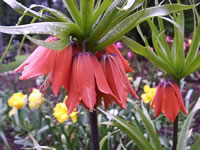 Crown Imperial Fritillaria imperialis Its time to plant bulbs!. Crown Imperials are impressive, spring flowering bulbs that have been cultivated since the 16th century. Once the stalk begins to emerge in mid-spring, it grows very quickly to a height of 3-4 feet and adorns itself with a crown of nodding, bell shaped flowers topped with a tuft of bright, glossy green leaves. Hardy in USDA zones 5-9 |
October 2, 2011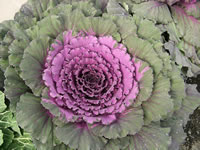 Ornamental Cabbage Brassica oleracea Its time to plant Kale! These annual plants are very showy, and come in a variety of colors, ranging from white to pinks, purples or reds. Ornamental Cabbages and Kales look much the same as their edible cousins, but the ruffled foliage is much fancier and more colorful. Brassica plants do not tolerate summer heat well, but are extremely cold-tolerant. Kale colors get brighter as the weather gets colder. |
October 9, 2011 Tree & Shrub Planting Time! 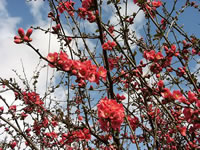 Flowering Quince Chaenomeles speciosa For a few brief weeks in late winter to early spring, when there is little to enjoy in the garden, the Flowering Quince bursts into brilliance as the brightly colored flowers emerge from the leafless stems. Branches from the previous year can be cut in late winter and forced into bloom indoors. Hardy in USDA zones 4-9 |
October 16, 2011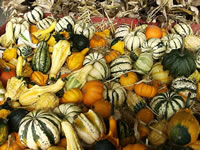 Gourds Cucurbita Vines Gourds are very closely related to cucumbers, Squash and melons. They have a growing season of anywhere from 120-180 days. DO NOT harvest gourds when they are still green on the vine. Wait until the stem where the gourd is attached to the vine turns brown. If you harvest gourds while the stems are still green, they will usually rot instead of drying. Drying Gourds properly takes months! |
October 23, 2011 Halloween Decorations! 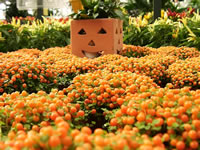 Pin Cushion Plants Nertera granadensis The Pin Cushion Plant is also commonly known as a Bead Plant or Coral Moss. It is a fast growing tender perennial that produces an abundance of tiny orange berries just in time for Halloween! Pin Cushion Plants are an excellent choice for growing in containers. They should be kept in a sunny location with a room temperature of 65-70 degrees. Hardy in USDA zones 9-11 |
|
|
||||
November 6, 2011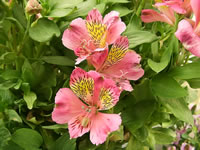 Peruvian Lily Alstroemeria Peruvian Lily plants are easy to care for, tuberous rooted perennials with bright green, lance shaped foliage that grow 2-3 feet tall. They produce loose clusters of speckled, 1½"-2" Azalea-like flowers on long, leafy stems in late spring into mid summer. Alstroemerias are suitable for growing in pots and can be maintained as house plants if you can provide them with a cool space and sufficient sun. Hardy in USDA zones 7-10 |
November 13, 2011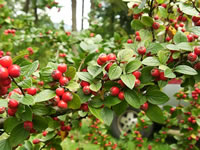 Cotoneasters Cotoneaster is an extremely diverse genus of attractive landscape plants that include creeping ground covers, dwarf sized bushes and tall sprawling shrubs. These deer resistant plants typically have small, pink or white flowers that resemble tiny, opening rose buds and attract Hummingbirds and Bees in the spring and early summer. The flowers are followed by bright red or orange berries which feed the Birds in the fall and winter. Hardiness zones vary |
November 20, 2011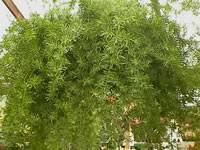 Asparagus Fern Protasparagus sp. There are several different species and varieties of Asparagus Fern that have been grown as house plants since the late 19th century because they are are one of the fastest growing, least demanding, easiest to care for plants for growing indoors. Asparagus Ferns produce tiny white flowers in late summer to fall, and will occasionally form red or black berries. They can be trained to cascade down from a hanging planter, or to grow up a totem as a vine. Hardy in zones 9-11 |
November 27, 2011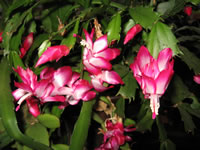 Holiday Cactus Schlumbergera sp. Most Christmas Cactus sold today are hybrids of this red flowering species. Schlumbergera are epiphytic plants that, in nature reside cordially with the Orchids and Epiphyllums in the crotches and branches of their host jungle trees. Look at the calendar and you decide what you want to call your Holiday Cactus a Christmas or Thanksgiving Cactus because Schlumbergera plants are capable of blooming at almost any time of the year Hardy in zones 9-12 |
December 4, 2011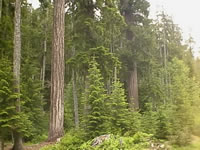 Christmas Trees! Living Christmas Tree Care Without a doubt, the freshest Christmas tree will be one that is still living. Many families will traditionally buy a living tree from a nursery each year, and then plant it into their landscape, along with the holiday memories it holds. Living trees take extra care, or they may not survive long enough to be planted in the yard. Select a tree that fits your needs for size and shape. Living trees can only be kept indoors for ten days. |
December 11, 2011 Christmas Trees! Living Christmas Tree Care Without a doubt, the freshest Christmas tree will be one that is still living. Many families will traditionally buy a living tree from a nursery each year, and then plant it into their landscape, along with the holiday memories it holds. Living trees take extra care, or they may not survive long enough to be planted in the yard. Select a tree that fits your needs for size and shape. Living trees can only be kept indoors for ten days. |
December 18, 2011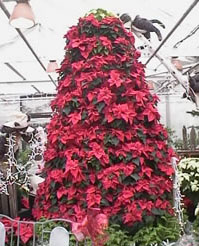 Poinsettia Plants Euphorbia pulcherrima Poinsettia Plants were first brought into the United States in 1825 by Joel Robert Poinsett, while he was serving as the first U.S. ambassador to Mexico. He found the plants growing wild on a hillside near Taxco, Mexico. The first Poinsettias were sold for Christmas in the US in about 1850. Poinsettias in the Garden? |
December 25, 2010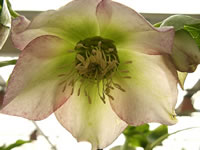 The Christmas Rose Helleborus niger According to legend, a young shepherdess named Madelon was tending her sheep one cold and wintry night. As she watched over them, a group of wise men and other shepherds passed by, bearing gifts for the newly born Jesus. Madelon wept, because she had no gifts to bring to the newborn King. Not even a simple flower... An Angel, upon hearing her weeping, appeared and brushed away a bit of snow to reveal a most beautiful white flower tipped with pink... The Christmas Rose. Merry Christmas! |
January 1, 2012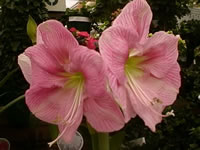 Amaryllis Hippeastrum Nothing can break the gloom, like a beautifully blooming House Plant in the dead of winter. The Amaryllis is one of the easiest of all flowering bulbs to force into bloom, making them very popular as gift plants during the holiday seasons. Amaryllis produce 4-6 huge, showy flowers on bare, 1-2 ft. stems. They are very easy to maintain in the home. Hardy in zones 9-11 |
|
Search The Garden Helper: